
Emails Accessible: Ensuring Readability for Everyone
Email is a crucial communication tool for businesses and individuals alike. However, not all emails are created equal when it comes to accessibility. With new legislation on digital accessibility on the horizon, it’s more important than ever to ensure that everyone can read and understand your emails, regardless of their abilities or disabilities.
This article will explore the concept of email accessibility and its importance and provide practical tips for making your emails more inclusive. We’ll also touch on the upcoming European legislation and its impact on marketers and businesses. But first, let’s start at the beginning.
What is email accessibility?
Email accessibility refers to designing and coding emails so that they can be easily read and understood by all recipients, including those with visual, auditory, motor, or cognitive disabilities. This includes ensuring that emails are compatible with assistive technologies like screen readers and can be navigated using a keyboard alone.
Why is email accessibility important?
- Inclusivity: By making your emails accessible, you ensure that your message reaches all intended recipients, regardless of their abilities.
- Broader reach: Accessible emails can be understood by a wider audience, potentially increasing your engagement rates and conversions.
- Customer satisfaction: When all your customers can easily interact with your emails, it improves customer satisfaction and loyalty.
- Legal compliance: With new accessibility laws coming into effect, making your emails accessible helps you stay compliant and avoid potential legal issues in the future. However, this shouldn’t be your primary motivation for making
New legislation for digital accessibility
The European Accessibility Act (EAA) will come into force on June 28, 2025. This legislation mandates that businesses ensure their digital products and services, including emails, are accessible to people with disabilities. While the primary focus here (in this article) is on email marketing, the EAA’s scope extends to a wide range of digital and physical products and services, ensuring inclusivity across the board. The EAA applies to all products sold in the EU, regardless of their origin, emphasising non-discrimination. If you want to learn more about the legislation, and whether your business falls under this new ruling, check out the official website here.
Key requirements for emails under the new legislation
- Readable text: Ensure all text is readable and can be perceived by assistive technologies, such as screen readers.
- Alternative text: Provide alternative text for images and other non-text content to ensure all recipients can understand the message.
- Colour contrast: Use sufficient colour contrast between text and background to enhance readability for visually impaired users.
- Keyboard navigation: To accommodate users who cannot use a mouse, make all email functionality accessible through keyboard navigation.
- Consistent navigation: Provide clear and consistent navigation throughout the email to help users quickly find information.
- Compliance guidance: Refer to Annex I of the EAA for detailed accessibility requirements and Annex II for possible solutions to ensure compliance.

Best practices for accessible emails
Creating accessible emails ensures that all recipients, including those with disabilities, can effectively engage with your content. Here are some streamlined best practices:
Text and contrast
Use a minimum contrast ratio of 4.5:1 for standard text and 3:1 for larger text to enhance readability and visability. Avoid relying solely on colour to convey information; instead, choose inclusive colour combinations. Online tools can help verify contrast ratios.
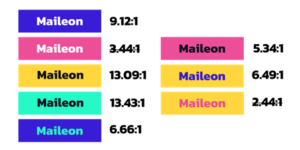
Font and size
Selecting the right font and size can significantly impact the readability of your emails. Opt for sans-serif fonts like Arial, Verdana, or Helvetica, with body text no smaller than 14px. Avoid italics or all caps for extended text to maintain readability.
Structure and readability
Organise content with clear headings (H1, H2, H3) to guide readers. Keep sentences and paragraphs short and concise — nobody wants to read an email that feels like a novel. And use bullet points and lists for quick, engaging information delivery.
Alt text and descriptions
Images in your emails should always include descriptive alt text, like “Woman smiling while using laptop” rather than just “Image.” Use empty alt text for decorative images to keep screen readers focused on essential content. Just remember, for spam detection reasons, this field shouldn’t be unnecessarily empty or repetitive either—it’s a two birds with one stone situation, keeping both accessibility and email filters happy!
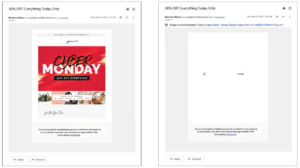
Links and buttons
Use descriptive link text, such as “Read our accessibility policy,” instead of using generic phrases like “Click here.” And ensure buttons are at least 44×44 pixels with ample spacing to prevent accidental clicks.
By adopting these practices, you can enhance user experience and ensure your emails are accessible to a wider audience.
Tools and resources for testing email accessibility
Now that we’ve covered the best practices and essentials to making your emails accessible, it might be helpful to put your efforts to the test. To ensure your emails meet accessibility standards, consider using the following tools:
- Screen readers: Maileon has a built-in screen reader in English. But if you aren’t so lucky to use Maileon for your email marketing automation, use NVDA (free, Windows) or VoiceOver (built-in, Mac) to test how your email sounds to visually impaired users. It’s like having a personal narrator for your emails!
- Contrast checkers: Maileon also has a built-in contrast checker. Tips pop-up to let you know when it’s recommended to optimise your texts. Tools like or Colour Contrast Analyser are alternatives that can help verify colour contrast ratios, ensuring your text is as readable as a bestseller.
- Email on Acid: This service offers accessibility checks as part of their email testing suite, so you can catch any issues before hitting send. It also comes in the Maileon package if you need the extra boost in accessibility.
Build your confidence by utilising these tools, and send out emails that are not only visually appealing but also accessible to everyone.
Examples of accessible emails
To truly understand the impact of accessible email design, let’s explore some real-world examples of successful campaigns and analyse what makes them effective:
Example 1: Harvard’s accessible
Harvard’s accessible email practices ensure that their communications are both visually appealing and easy to navigate across devices. By using simple, flexible templates with one- or two-column layouts, they enhance readability. They avoid tables for layout, recognising the challenges they pose for assistive technology users, and instead use native tools like text and columns to maintain a logical flow. This thoughtful approach reflects Harvard’s commitment to inclusivity, making their emails accessible to all recipients.
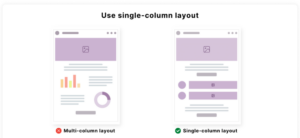
Example 2: Email on Acid’s accessible email
Picture an email campaign from Email on Acid that effortlessly adapts to mobile devices with its single-column layout. This design choice not only enhances readability but also ensures easy navigation across various screen sizes. To further improve accessibility, the campaign incorporates large, tappable buttons, making it user-friendly for individuals with motor impairments.
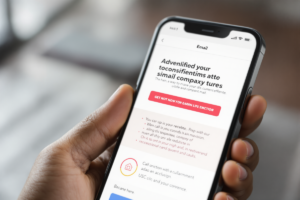
*AI generated image to illustrate example.
Example 3: AbilityNet’s accessibility emails
Imagine receiving an email from AbilityNet that feels effortlessly digestible, thanks to its strategic use of bullet points and concise paragraphs. This thoughtful design choice not only makes the content visually appealing, but also enhances its accessibility for screen readers, ensuring a smooth reading experience for all users. Furthermore, AbilityNet underscores the importance of including a plain text version of the email. This ensures that every recipient, regardless of their email client, can access the content without any barriers.
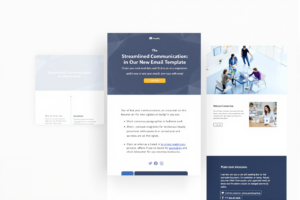
*AI generated image to illustrate example.
These examples demonstrate how thoughtful design and attention to accessibility can create engaging and inclusive email experiences for all users.
The impact of accessibility on email performance
At this point, you should have read pretty much everything there is to know about accessibility in email, except for the fact that it is also linked to a performance increase. Here’s how:
Higher Engagement rates: Crafting accessible and engaging email content not only captures a broader audience’s attention but also enhances user interaction. By using clear subject lines, preheader text, and descriptive links, you increase open and click-through rates, as recipients know exactly what to expect and where they’ll be taken. This clarity and ease of interaction keep users engaged, reducing unsubscribe rates and ensuring that all recipients, regardless of ability, can enjoy and stay connected with your content.
Better deliverability: Accessible emails often maintain a better text-to-image ratio, positively impacting deliverability. By balancing visual and textual content, your emails are more likely to reach the inbox rather than being. Properly filling in the alt texts with varied and descriptive terms also helps ensure your emails smoothly bypass the spam filters. Discover more on how to stay out of the spam box here, and how to stay on top of Gmail’s regulations here.
Expand your target audience: By prioritising accessibility in your email campaigns, you open the door to a wider range of recipients, including those with disabilities. This inclusivity not only broadens your reach but also enhances your brand reputation as a company that values diversity and accessibility. By making your emails accessible to everyone, you tap into new segments of the market, fostering growth and engagement across a more diverse audience.
Overall, by prioritising accessibility, you’re creating a more inclusive experience and driving better results for your email marketing efforts.
Conclusion
As we move towards a more inclusive digital world, making your emails accessible is not just a legal requirement but a moral imperative, as well as a business opportunity. By following the best practices outlined in this article, you can ensure that your email campaigns reach and engage all of your audience, regardless of their abilities.
Remember, accessibility is an ongoing process. Regularly test your emails, gather feedback from diverse users, and stay updated on the latest accessibility guidelines and technologies. By prioritising accessibility, you’re not only complying with legislation but also demonstrating your commitment to inclusivity and customer satisfaction.
Start implementing these accessibility practices today, and watch as your email campaigns become more effective and reach a wider audience than ever before.
Have you read these blogs yet?
-
Holiday Email Marketing: 5 Steps to Boost Your Festive Campaigns
Discover the 5 steps that separate successful holiday email marketing campaigns from expensive festive email failures
-
No-reply emails are (not) the answer
No-reply emails are (not) the answer
-
DOI reminders: essential or excessive?
When it comes to email marketing, the double opt-in (DOI) process remains a core pillar for establishing trust with your subscribers.

Let’s talk!
Whether you’re looking for a new platform, a partnership or just want to have a cup of coffee and a chat: we’d love to hear from you.
